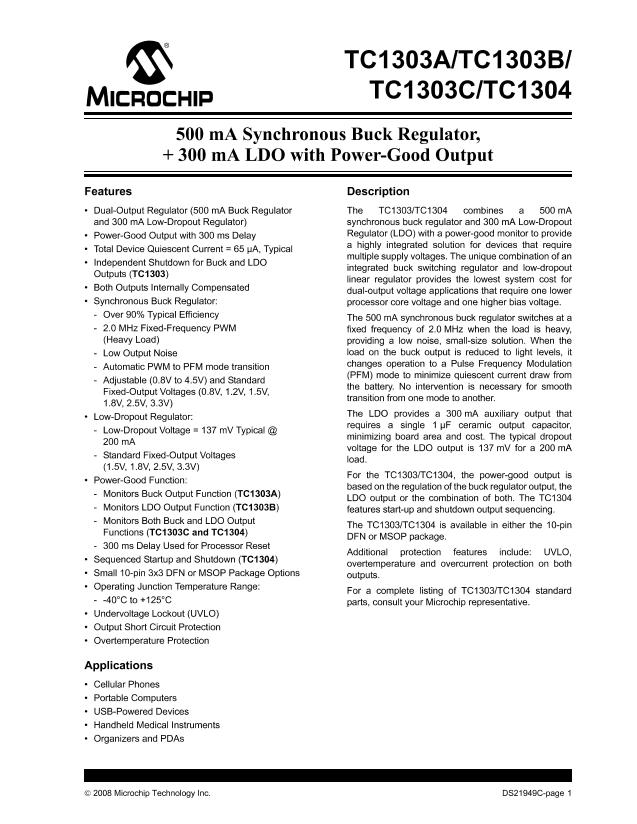
TC1303C-1A1EMF
| Model | TC1303C-1A1EMF |
| Description | 0.5 A SWITCHING REGULATOR, 2400 kHz SWITCHING FREQ-MAX, PDSO10, 3 X 3 MM, 0.9 MM HEIGHT, PLASTIC, DFN-10 |
| PDF file | Total 38 pages (File size: 756K) |
| Chip Manufacturer | MICROCHIP |

TC1303A/TC1303B/TC1303C/TC1304
5.0
5.1
APPLICATION CIRCUITS/
ISSUES
Typical Applications
An additional V
IN2
capacitor can be added to reduce
high-frequency noise on the LDO input voltage pin
(V
IN2
). This additional capacitor (1 µF on page 5) is not
necessary for typical applications.
The TC1303/TC1304 500 mA buck regulator + 300 mA
LDO with power-good operates over a wide input volt-
age range (2.7V to 5.5V) and is ideal for single-cell Li-
Ion battery-powered applications, USB-powered
applications, three-cell NiMH or NiCd applications and
3V to 5V regulated input applications. The 10-pin
MSOP and 3x3 DFN packages provide a small footprint
with minimal external components.
5.4
Input and Output Capacitor
Selection
5.2
Fixed Output Application
A typical V
OUT1
fixed-output voltage application is
shown in “Typical
A 4.7 µF
V
IN1
ceramic input capacitor, 4.7 µF V
OUT1
ceramic
capacitor, 1.0 µF ceramic V
OUT2
capacitor and 4.7 µH
inductor make up the entire external component
solution for this dual-output application. No external
dividers or compensation components are necessary.
For this application, the input voltage range is 2.7V to
4.2V, V
OUT1
= 1.5V at 500 mA, while V
OUT2
= 2.5V at
300 mA.
As with all buck-derived dc-dc switching regulators, the
input current is pulled from the source in pulses. This
places a burden on the TC1303/TC1304 input filter
capacitor. In most applications, a minimum of 4.7 µF is
recommended on V
IN1
(buck regulator input voltage
pin). In applications that have high source impedance,
or have long leads, (10 inches) connecting to the input
source, additional capacitance should be used. The
capacitor type can be electrolytic (aluminum, tantalum,
POSCAP, OSCON) or ceramic. For most portable
electronic applications, ceramic capacitors are
preferred due to their small size and low cost.
For applications that require very low noise on the LDO
output, an additional capacitor (typically 1 µF) can be
added to the V
IN2
pin (LDO input voltage pin).
Low ESR electrolytic or ceramic can be used for the
buck regulator output capacitor. Again, ceramic is
recommended because of its physical attributes and
cost. For most applications, a 4.7 µF is recommended.
Refer to
for recommended values. Larger
capacitors (up to 22 µF) can be used. There are some
advantages in load step performance when using
larger value capacitors. Ceramic materials X7R and
X5R have low temperature coefficients and are well
within the acceptable ESR range required.
5.3
Adjustable Output Application
A typical V
OUT1
adjustable output application is also
shown in “Typical
For this
application, the buck regulator output voltage is
adjustable by using two external resistors as a voltage
divider. For adjustable-output voltages, it is
recommended that the top resistor divider value be
200 kΩ
.
The bottom resistor divider can be calculated
using the following formula:
TABLE 5-1:
TC1303A, TC1303B, TC1303C,
TC1304 RECOMMENDED
CAPACITOR VALUES
C(V
IN2
)
none
none
C
OUT1
4.7 µF
22 µF
C
OUT2
1 µF
10 µF
EQUATION 5-1:
R
BOT
Example:
R
TOP
V
OUT1
V
FB
R
BOT
R
BOT
=
=
=
=
=
200 kΩ
2.1V
0.8V
200 kΩ x (0.8V/(2.1V – 0.8V))
123 kΩ (Standard Value = 121 kΩ)
V
FB
-
= R
TOP
×
⎛
-------------------------------
⎞
⎝
V
OUT1
–
V
FB
⎠
min
max
C(V
IN1
)
4.7 µF
none
For adjustable-output applications, an additional R-C
compensation is necessary for the buck regulator
control loop stability. Recommended values are:
R
COMP
C
COMP
=
=
4.99 kΩ
33 pF
©
2008 Microchip Technology Inc.
DS21949C-page 25












































